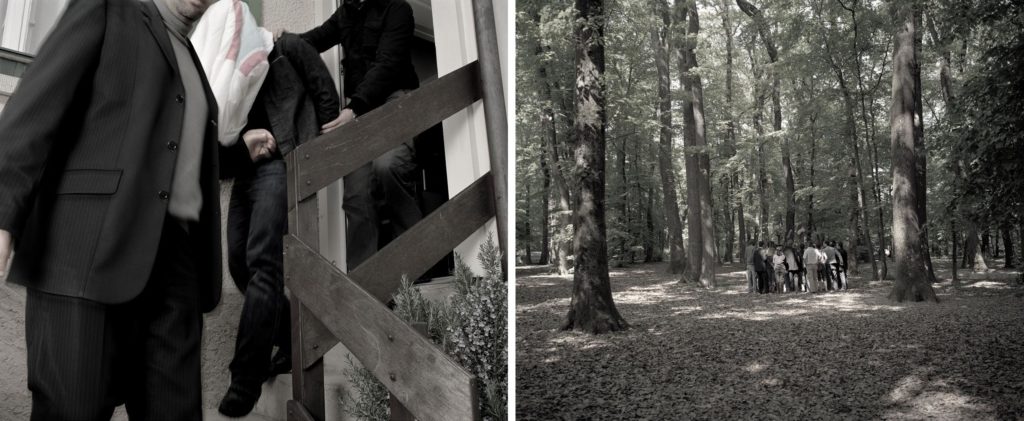Opening: Friday, November 21, 2014, 7 p.m.

The exhibition New Conceptual Practices is presented as part of an exchange project with the Zurich-based gallery Annex14. Warsaw’s Profile Foundation is showing works by two artists, who in their practice have cultivated the conceptual impulse of reflection on the language of art, on the mechanisms of its perception and power. Although using different media and being informed by different traditions, Jérôme Leuba and Christian Vetter both question the obviousness of what and how we see.
Jérôme Leuba’s practice draws on media images while remaining distanced from the visual hurly-burly of mass media. As he says, he is interested not so much in the production of images as in the modes of perceiving and working with them. Preoccupied with the mechanisms by which images exert their power, with their violence and memory, he avoids speculation in his works, reaching for representations that are only seemingly obvious and can’t be unequivocally interpreted. What he shows to the viewer usually triggers off the memory of other images, rooted deeply in the collective consciousness.
For over ten years now he has created works under the shared title of Battlefield. These photographs, installations, actions, performances, videos, and films are a kind of tension fields, where a game is played between the seen and that which, in spite of its absence, emerges from our media-trained memory. In one part of a photographic diptych called battlefield#36/pictureless (2007), a group of reporters have closely surrounded an invisible (and non-existent) object of their attention. The other photograph, showing an arrest scene, even though staged, evokes similar images familiar from the press or TV news.
Under the title of Living Sculptures, the artist orchestrates a kind of actions featuring naturally behaving persons, performing ordinary and rather inconspicuous activities. Unannounced and sometimes even difficult to notice, the Living Sculpture events play out the ambiguity between the real and at the same time inscribed in the field of art.

Christian Vetter is a painter absorbed, as he says, by the linguistic nature of art: “I tried to understand how this language is made out. I think about the differences between the literal and painterly language. I think it is interesting question: what happens to a word once it becomes a material thin, once it is a painted.”
In his paintings and drawings from recent years the artist paints texts which he transforms into images. He is interested in the possible references of these painted words-images, which cease to refer to their designata. Individual letters are imbued with visual meanings, becoming part of the painting’s or drawing’s structure. The way they are painted/drawn brings typographic functionality to mind rather than calligraphic artistry. Vetter has developed characteristic, simplified lettering that emphasizes structural value rather than shape.
Links between painting language and painted words find an extension in his Painting Manifesto (2010), comprised of 33 works on paper. Their brief statements deal with painting and are often humorous: DEFINE VAGUENESS, HATE FROM FIRST SIGHT. Despite its title, the Manifesto proclaims nothing and has no declarative character; rather, it is a manifestation of painting as a language that avoids representationality and platitude. The language of painted words makes it possible to reference something that is absent from the picture; it also sheds the words’ meaning by turning them into purely visual signs. The duality of this linguistic and visual record complicates the relationships between the signifier and the, ultimately indeterminate, signified.
Curated by Suzanne B. Friedli
Jérôme Leuba (1970) lives and works in Geneva. He began his artistic career as an author of films and has now expanded to other media, including photography, video, installation, or performance art.
Solo exhibitions: Centre pour l’Image Contemporaine, Geneva (1997, 2003); Kunsthall, Oslo (2005); MAMCO, Geneva (2005, 2007); Centre culturel suisse, Paris (2006); Centre d’art de Neuchâtel (2011); Casal Solleric, Palma de Mallorca (2013). Group exhibitions: Museum of Contemporary Art (KIASMA), Helsinki (1998); Centre d’art contemporain, Rome (1999); Centre d’Art Contemporain, Ceneva; (2000, 2003, 2004, 2005); Contemporary Art Center, Vilnius (2004, 2009); Martin Gropius Bau, Berlin (2005); Kunsthaus Museum, Zurich (2008); Fri-Art Kunsthalle, Fribourg (2008); Museum für Gegenwartskunst, Basel (2010); Galerija Skuc, Ljubljana (2011); Fotomuseum Winterthur, Winterthur (2012).
Christian Vetter (1970) lives and works in Zurich. His painting evolved from expressive, color-intensive, abstraction to figuration, in order to then return to limited-color abstract structures. Besides painting and drawing, Vetter uses media such as video, photography, or installation. Solo exhibitions: Galerie Brigitte Weiss, Zurich (2004, 2006, 2007); Museum Langmatt, Baden (2007); Kunstmuseum St.Gallen, St. Gallen (2008); Villa Merkel Galerien der Stadt Esslingen am Neckar (2009); Yvon Lambert Gallery, New York (2010); Trudelhaus,Baden (2010); Forum Vebikus, Schaffhausen (2011); Hilfiker Kunstprojekte, Luzern (2012). Group exhibitions: Helmhaus Zurich, Zurich (2002, 2005, 2013) Kunstmuseum St. Gallen, St. Gallen (2006, 2007, 2011); Kunsthaus, Zurich (2008);Kunstmuseum, Bern (2009); Museum Marta Herford (2009); SMAK, Gent (2009); Art en Ile, Geneva; (2009); Centre for Contemporary Art, Vilnius (2009); Musée des Beaux-Arts, Le Lôcle (2010); Shedhalle, Zurich (2010);), 2012); Centro d`arte contemporanea, Bellinzona (2013).
The project is supported by

